Chart Recorders
Introduction to Chart Recorders
A
chart recorder is an instrument used to record various process and electrical signals. The most traditional chart recorders record
data on paper. The paper is passed under a pen and the pen is deflected in proportion to the signal. The result is a graph or chart of the data.
Chart recorders are available in single or multichannel styles (single or multipen) and in various configurations. Many of today's chart recorders
can also record information in a digital format for download to a computer.
There are scores of data recorder models on the market, ranging from several price ranges. Extremes—gone are the days when most
data recorders could be classified as either simple, midrange, or complex. In recent years, for example, conventional analog chart recorders have
hybridized with data loggers, and PC-based functions have been added to most of the product categories.
OMEGA Engineering offers a wide range of
chart recorders in Malaysia.
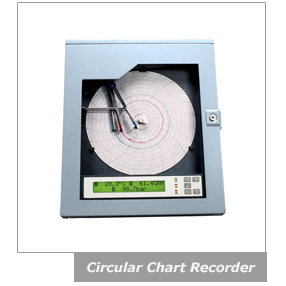
Learn more about chart recorders
Typical Uses of Chart Recorders
Chart recorders are a familiar sight in manufacturing plants, where they track such variables as temperature, pressure, flow, pH,
and humidity. Laboratories, meanwhile, use them to monitor scientific and engineering data generated in testing, diagnostics,
statistical analysis, and other work requiring a graphic record.
When Should I Use a Chart Recorder?
When the process to be tracked involves limited variables that do not require a PC-based interface, paper and pen can still be the way to go.
The advantage of a circular chart is its intuitiveness: at a glance, it gives a complete history of each selected variable over a specified period—a truly
continuous display of a trend’s change with time.
Choose the right recorder
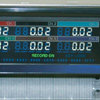 Strip Chart Recorders
Strip Chart Recorders
Strip chart recorders consist of a roll or strip of paper that is passed linearly beneath one or more pens. As the signal changes
the pens deflect producing the resultant chart. Strip chart recorders are well suited for recording of continuous processes. Sections
of the paper can be torn off and archived for future reference. Strip chart recorders are commonly used in laboratory as well as
process measurement applications.
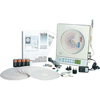 Circular Chart Recorders
Circular Chart Recorders
A circular chart recorder records data in a circular format. The paper is spun beneath one or more pens. The pens are deflected in
proportion to the varying signal resulting in a circular chart. Circular chart recorders are ideal for batch processes where a set
process time is known. The charts are normally designed to rotate in standard time periods, such as 1 hour, 24 hours, 7 days, etc.,
although many recorders are flexible enough to accommodate non-standard time periods.
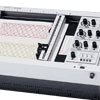 XY Recorders
XY Recorders
Y recorders accept two inputs and create a chart or graph of one input versus the other. They are commonly used to determine
the relationship between the two inputs. For example in a chemical process, an XY recorder might be used to monitor the effect
temperature has on the pressure of the process.
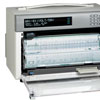 Hybrid Recorders
Hybrid Recorders
A hybrid recorder can function as a recorder or data logger. Like a standard recorder the hybrid recorder can generate a chart
of the inputs. However, it can also produce a digital stamp of the data similar to a data logger. They are commonly available in
multichannel designs although one print head normally handles all channels. This makes the hybrid recorder a cost effective
solution for multichannel systems although the response time is not as fast as recorders which have a unique pen for each channel.
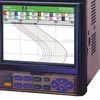 Paperless Recorders
Paperless Recorders
Paperless recorders are one of the latest types of recorders to emerge on the market. Paperless recorders display the chart
on the recorders' graphic display rather than print the chart on paper. The data can normally be recorded in internal memory
or to a memory card for later transfer to a computer. The major benefit of paperless recorders is conservation of paper and
easy transfer to a computer.
Frequently Asked Questions
How to Select a Chart Recorder?
Many applications are suitable and require the installation of a chart recorders. Before choosing one, make sure you consider the following questions:
- How many inputs need to be recorded?
- What types of inputs need to be recorded?
- Do different input types need to be recorded in the same unit?
- What type of recording is required?
- Multiplex scanning (what minimum scan cycle is required?)
- Is a communciation interface required?
- Is recorder to be bench style or panel mounting?
- What type of instrument power is available?
- Is log-type recording desirable instead of/in addition to trend recording?
- Is color differentiation available for trend lines?
- Is message printing required?
- Is the recorder to perform alarm functions?
- How many setpoints per channel?
- What types of alarms: threshold, rate delta?
- Are physical relay contacts available for external alarm output?
Shop for Chart Recorder in Malaysia
The OMEGA Engineering Singapore office services all of Southeast Asia and Taiwan. We have Application Engineers and Sale Support Staff ready to assist
you with your technical questions, quotations and orders. A one-stop source for process measurement and control based in the heart of Singapore.
We provide support through web chat, e-mail and telephone. Come visit our office; view our
contact page for location details.
Recorder | Related Products
↓ View this page in another language or region ↓

 Strip Chart Recorders
Strip Chart Recorders
 Circular Chart Recorders
Circular Chart Recorders
 XY Recorders
XY Recorders
 Hybrid Recorders
Hybrid Recorders
 Paperless Recorders
Paperless Recorders

 Registradores de Gráfico
Registradores de Gráfico
 Enregistreurs à chartes
Enregistreurs à chartes
 Graficadores de Cinta
Graficadores de Cinta
 Graficadores de Cinta
Graficadores de Cinta
 Chart Recorders
Chart Recorders
 Diagramoptagere
Diagramoptagere
 Schreibern
Schreibern
 Registratori grafici
Registratori grafici
 Chart Recorders
Chart Recorders
 Registrador de Gráficos
Registrador de Gráficos
 Chart Recorders
Chart Recorders
 Chart Recorders
Chart Recorders
 图表记录仪
图表记录仪
 Chart Recorders
Chart Recorders
 チャートレコーダー
チャートレコーダー
 Enregistreur graphique
Enregistreur graphique
 차트 레코더
차트 레코더
 Chart Recorders
Chart Recorders
 Chart Recorders
Chart Recorders
 Chart Recorders
Chart Recorders
 Chart Recorders
Chart Recorders
 Chart Recorders
Chart Recorders